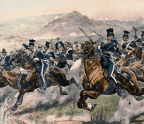

There it was again. He was sure of it now. Muffled by the dense Amazonian undergrowth came the low rumbling of a vehicle moving at barely a crawl. Ecuadorian Corporal 1st Class José Maria Marasco froze stock-still in his outpost as he tried to determine the vehicle’s direction of movement. It seemed closer now, and he could hear the snapping of branches beneath the vehicle’s tires. Then he heard their muted voices—the hated Peruvians. An officer giving orders. A sergeant giving directions. And they were all coming toward him. The war he knew was coming had arrived in the Cenepa Valley.
Marasco whispered what he heard and saw into the mouthpiece of his landline and then silently made his way back to his unit.
Ecuadorian and Peruvian units had patrolled the disputed valley for years without incident, despite their mutual hatred. Sometimes their officers even got together for talks. Then, in 1995, Peruvian forces invaded the disputed area, seeking to evict the Ecuadorian troops dug in on the high ground overlooking the river basin.
The Cenepa War, a fierce little fight of 34 days, was the latest in a series of wars between the South American neighbors over their disputed boundary. The two had most recently come to blows in 1941 and 1981. Ecuador had not defeated Peru since the 1829 Battle of Tarqui.
The dispute was a complex one, dating from Spain’s colonial rule, when Madrid oversaw most of Latin America through its Viceroyalties of Peru and New Granada and many smaller political units. Spain frequently changed the borders and responsibilities of the viceroyalties to ease the administration of its colonies and deal with Portuguese incursions along the Amazon River. One such changeof the province of Guayaquil to Peru. Based on these decrees, Peru claimed the disputed lands on the legal principle of (as you possess, so shall you possess). However, in 1819 the Liberator, Simón Bolívar, through the Congress of Angostura, claimed the province of Quito (in present-day Ecuador) and parts of Jaén and Maynas provinces (in present-day Peru) for his Gran Colombia.




